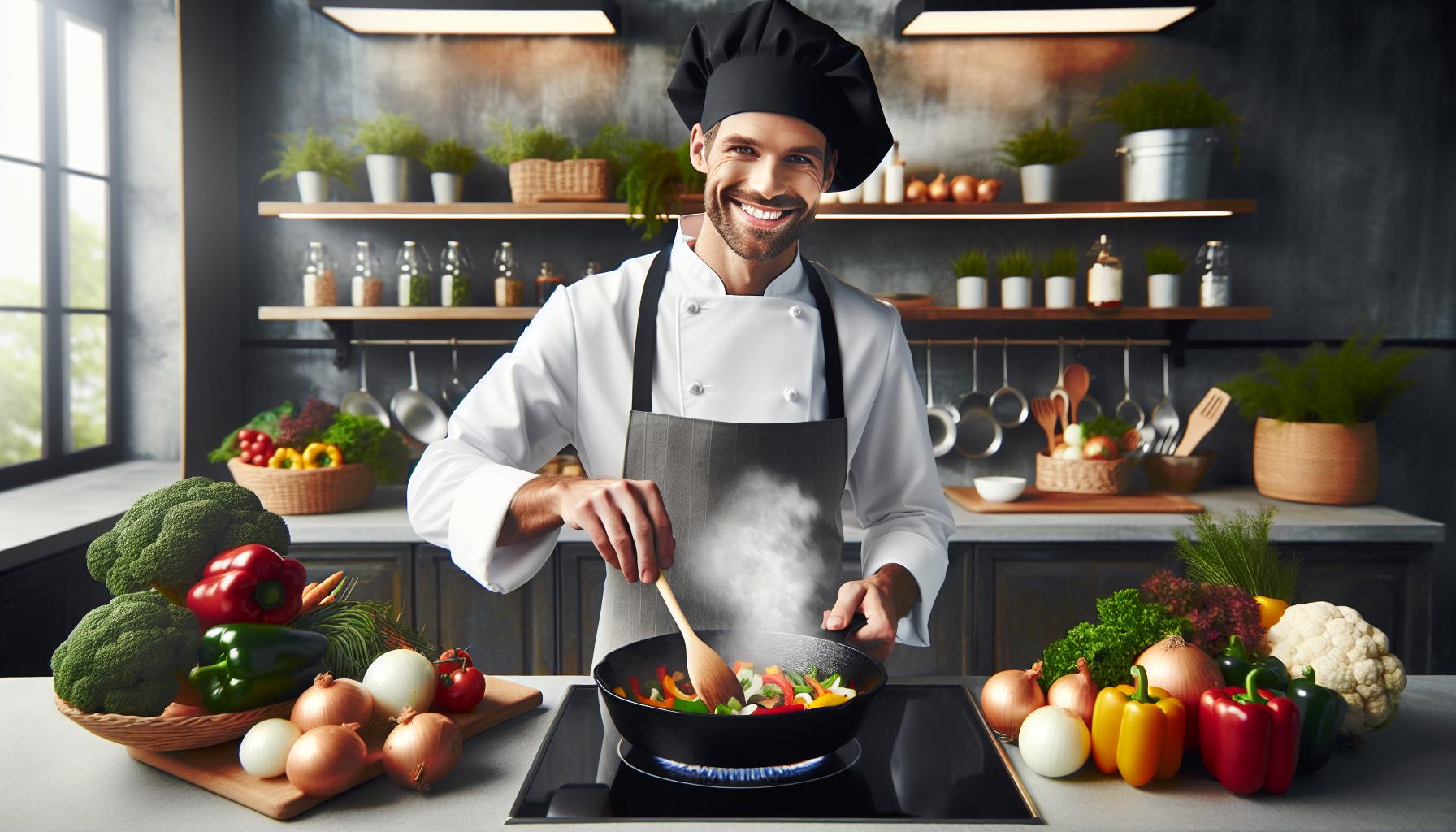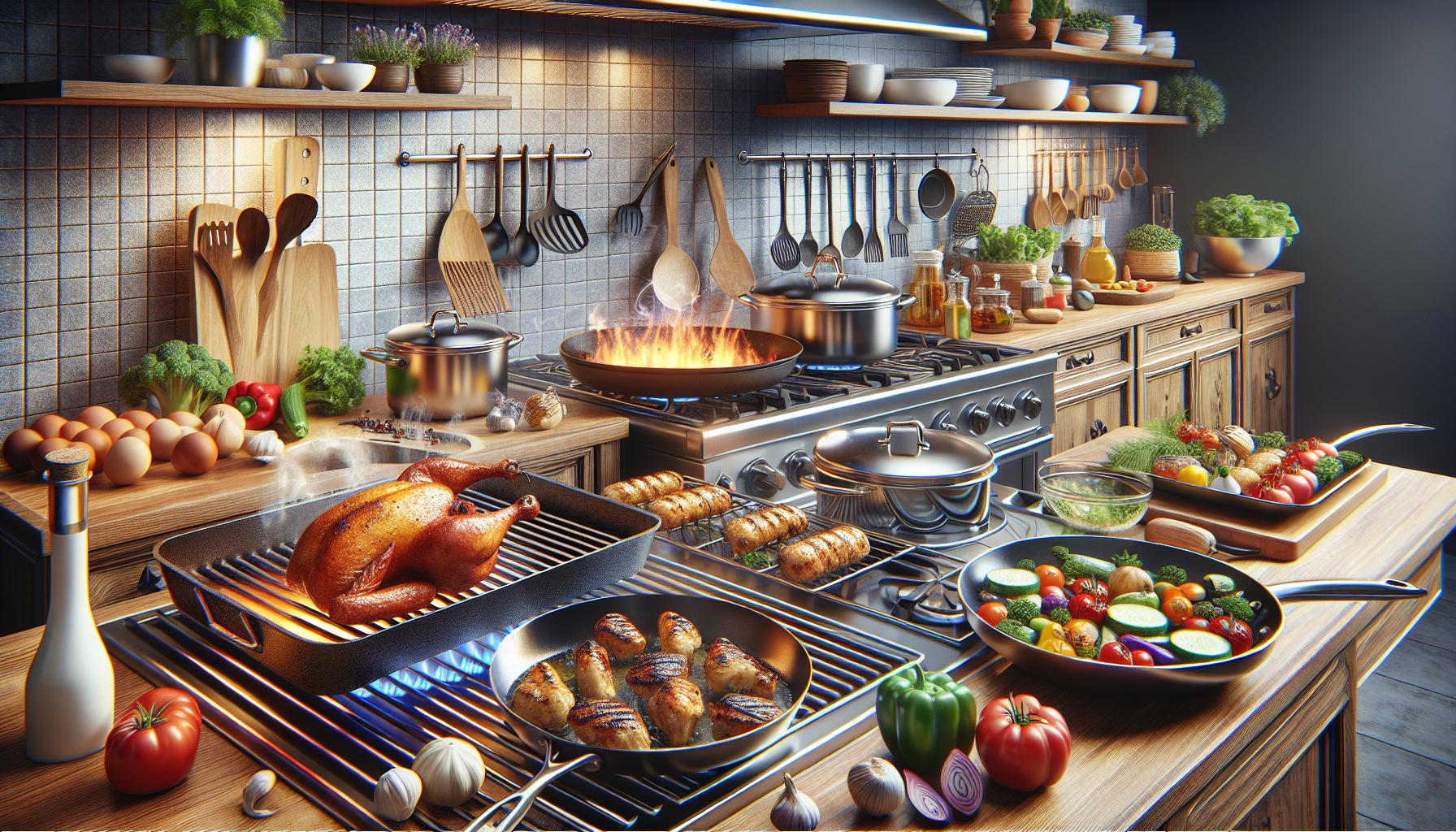Physical Address
304 North Cardinal St.
Dorchester Center, MA 02124

Mastering cooking techniques transforms ordinary ingredients into culinary masterpieces. Whether someone’s a novice cook or an experienced chef these fundamental methods serve as the building blocks for creating delicious meals. From searing and braising to roasting and poaching there’s a whole world of techniques waiting to be explored.
The journey through cooking techniques isn’t just about following recipes – it’s about understanding how heat temperature and time interact with food. Each method brings out unique flavors textures and aromas that can elevate a simple dish into something extraordinary. It’s like having a magical toolbox where every technique adds its own special touch to the final creation.
Cooking methods fall into three primary categories: dry-heat, moist-heat, and combination cooking techniques. Each method creates distinct flavors textures through specific temperature ranges and cooking environments.
Dry-heat methods use hot air or fat to cook food without moisture:
Moist-heat techniques use water or steam as the primary cooking medium:
These techniques merge dry and moist heat for complex flavor development:
Each method transfers heat differently affecting cooking time texture flavor development. Temperature control remains essential for achieving desired results across all techniques.

Dry-heat cooking methods use hot air or fat to cook food without adding moisture. These techniques create distinct textures through browning reactions that enhance flavor compounds.
Roasting involves cooking food in an oven with temperatures between 375°F and 450°F. The process creates a browned exterior while maintaining interior moisture through fat-based basting or initial searing. The technique works best for large cuts of meat, poultry, fish or vegetables.
| Food Type | Roasting Temperature | Average Cooking Time |
|---|---|---|
| Beef Roast | 375°F | 20 minutes per pound |
| Whole Chicken | 425°F | 15 minutes per pound |
| Root Vegetables | 400°F | 30-45 minutes total |
Broiling uses direct heat from above at temperatures reaching 550°F. Grilling applies heat from below using charcoal or gas flames. Both methods create distinctive char marks through the Maillard reaction at high temperatures.
| Technique | Heat Source | Best For |
|---|---|---|
| Broiling | Top heating element | Steaks, fish fillets |
| Grilling | Bottom flames/coals | Burgers, vegetables |
Sautéing involves cooking food quickly in a small amount of hot oil over medium-high heat. Stir-frying uses higher heat with constant motion in a wok. The techniques seal in flavors while creating crisp textures.
| Method | Pan Type | Temperature |
|---|---|---|
| Sautéing | Sauté pan | 350°F-375°F |
| Stir-frying | Wok | 400°F-450°F |
Moist-heat cooking methods use water or steam to transfer heat to food. These techniques create tender textures while preserving moisture content in ingredients.
Boiling involves heating liquid to 212°F (100°C) at sea level, producing large bubbles that break the surface rapidly. This technique works effectively for pasta, grains, root vegetables or hearty greens. Simmering maintains temperatures between 185-205°F (85-96°C), creating gentle bubbles that rise slowly to the surface.
| Method | Temperature | Bubble Activity | Best For |
|---|---|---|---|
| Boiling | 212°F/100°C | Large, rapid | Pasta, grains |
| Simmering | 185-205°F/85-96°C | Small, gentle | Stocks, sauces |
Steaming cooks food through direct contact with water vapor in a sealed environment. Foods rest on a perforated surface above boiling water, preserving nutrients better than other moist-heat methods. Common steamed items include vegetables, dumplings or fish fillets.
Poaching uses liquid temperatures between 160-180°F (71-82°C) to cook delicate ingredients. The cooking liquid often includes aromatics like herbs, wine or stock to enhance flavors. This gentle technique produces tender results for eggs, fish or chicken breast.
| Method | Temperature | Cooking Medium | Ideal Foods |
|---|---|---|---|
| Steaming | 212°F/100°C | Water vapor | Vegetables, dumplings |
| Poaching | 160-180°F/71-82°C | Flavored liquid | Eggs, fish, poultry |
Combination cooking techniques merge dry and moist heat methods to create complex flavors and tender textures. These methods excel at transforming tough cuts of meat into succulent dishes through extended cooking times.
Braising starts with searing ingredients at high heat (400-450°F) to develop a caramelized exterior crust. The process continues by partially submerging the food in flavored liquid at low temperatures (275-325°F) in a covered pot. Common braising liquids include stock, wine or beer combined with aromatics like onions, carrots and herbs. This technique breaks down collagen in tough cuts of meat such as chuck roast, short ribs or lamb shanks into rich gelatin. The result creates fork-tender meat with concentrated flavors from both the initial sear and the reduced cooking liquid.
Stewing differs from braising by cutting ingredients into uniform pieces and fully submerging them in liquid. The cooking temperature stays between 160-180°F to create tender meat while vegetables retain their shape. Ingredients cook together in seasoned liquid for 2-3 hours until the meat becomes tender and the flavors meld. Classic stews feature beef chuck, lamb shoulder or chicken thighs combined with root vegetables like potatoes, carrots and parsnips. The cooking liquid reduces to create a naturally thickened sauce rich in nutrients extracted from the meat and vegetables.
Advanced technology revolutionizes traditional cooking methods through precise temperature control and innovative heating mechanisms. These techniques enhance flavor preservation while offering healthier cooking alternatives.
Sous vide cooking employs vacuum-sealed bags and temperature-controlled water baths to achieve precise doneness. Food items cook at consistent temperatures between 130°F to 185°F (54°C to 85°C) for extended periods, ensuring even heat distribution throughout. This method eliminates the risk of overcooking while retaining natural juices, vitamins, and minerals. Professional kitchens utilize sous vide for premium cuts of meat, seafood, and vegetables, achieving restaurant-quality results. The technique produces exceptionally tender proteins with minimal moisture loss, maintaining food’s original texture and nutritional content.
Air fryers circulate hot air at temperatures up to 400°F (204°C) around food items to create crispy exteriors without deep frying. This countertop appliance reduces oil usage by 70-80% compared to traditional deep fryers. Foods like chicken wings, french fries, vegetables receive a golden-brown crust with minimal added fat. Air fryers preheat in 3-5 minutes, cutting traditional cooking times by 25%. The technology accommodates various dishes from crispy tofu to roasted nuts, offering versatility in healthy meal preparation. Digital controls enable precise temperature adjustments for optimal cooking results across different ingredients.
A well-equipped kitchen contains specific tools matched to each cooking method. Here’s a comprehensive breakdown of essential tools by technique:
| Tool Category | Temperature Range | Common Uses |
|---|---|---|
| Cast Iron | Up to 500°F | Searing, roasting |
| Stainless Steel | Up to 600°F | Sautéing, frying |
| Nonstick | Up to 400°F | Eggs, delicate foods |
| Enameled Cast Iron | Up to 450°F | Braising, stewing |
Quality tools impact cooking results significantly. Materials matter: stainless steel excels at high heat cooking while nonstick surfaces work best for delicate foods at medium temperatures. Each tool serves specific functions creating optimal results across different cooking techniques.
Understanding various cooking techniques empowers home cooks to create exceptional dishes with confidence. From traditional methods like roasting and braising to modern innovations such as sous vide and air frying each technique offers unique ways to transform ingredients.
The right combination of heat temperature and time along with proper tools can elevate everyday cooking into culinary excellence. Whether it’s achieving the perfect sear creating tender braises or mastering precise temperature control these fundamental techniques serve as building blocks for endless creative possibilities in the kitchen.
Mastering these cooking methods isn’t just about following recipes – it’s about understanding the science behind each technique and how it affects food. This knowledge opens doors to culinary creativity and helps create more flavorful nutritious meals.